中文导读
以马赫数大于5的速度飞行的超高音速飞机在高空飞行时,飞机表面会产生超高温度,这是限制飞机提速的重要原因之一。而日前中英两国科学家团队发现的一种新的耐高温、高韧性的碳化物陶瓷涂层将助力超音速飞机提速。若民用超音速飞机能够实现,全球旅行时间将大幅削减,在数小时内横穿全球不再是个梦。
A new ceramic material could withstand the heat of Mach 5 and above.

FRICTION burns. And the friction of the air on something travelling at five times the speed of sound burns hot. The leading edge of such an object can easily reach a temperature of 3,000°C. Inconveniently, that is above the melting point of most materials used by engineers, which makes it hard to design things like wings and nose cones for aircraft intended to achieve hypersonic velocities. The lure of hypersonic flight is such, though, that many are trying to do so. The world’s air forces would love such planes. And for civilians (at least, for those with deep pockets), the idea of being able to jet in a couple of hours from Britain to Australia sounds extremely attractive.
Among those lured are Ping Xiao at the University of Manchester, in England, and Xiang Xiong at Central South University in Changsha, China, and their colleagues. And they think they have come up with a new material that might provide the answer.
Their novel substance is a ceramic. That is no surprise. Ceramics have strong bonds between their atoms—unlike metals, in which the electrons in those bonds have more freedom to move around. This gives ceramics high melting points, permitting them to be deployed in hot circumstances. But it also makes them brittle. That fragility became notorious when ceramic tiles were chosen as the re-entry heat shields for America’s space shuttles. Each of those craft was fitted with more than 24,000 tiles made from high-grade silica sand. The tiles were indeed heat-resistant. They were also, however, so brittle that they had to be glued to the spacecraft, rather than drilled and bolted on. Moreover, many needed replacing after each mission. This arrangement proved so fragile that, when some of the tiles on a shuttle called
Columbia
were damaged by a piece of foam that broke free during an ascent into space in 2003, the heat shield failed on re-entry, and the vehicle and its crew were lost.
Dr Xiao and Dr Xiong aim, therefore, to add flexibility to ceramic materials without lowering their melting points, and also without reducing their resistance to ablation—the wearing away of material caused by the extreme scouring that takes place at hypersonic speeds and their associated temperatures. Their starting point is what is known as a carbon-carbon composite. This is a matrix of carbon reinforced with carbon fibres. Such composites are widely used in the aerospace industry because they are strong, light and flexible. They would not, however, survive 3,000°C. To protect them from this level of heating the researchers used a process called reactive melt infiltration to infuse the composite with a liquid mixture of zirconium(锆), titanium(钛), carbon and boron(硼). When this happens, the composite acts as a sponge. It draws in the liquid, which then reacts to form a carbide(碳化物).
Carbides are tough ceramic compounds formed when carbon combines with other elements. The trick which the process pulls off is to coat the carbon fibres in the original material with the complex carbide created during the infusion. That retains those fibres’ mechanical strength and flexibility while protecting them from extreme temperatures. In tests they reported earlier this year, the researchers found that their carbide coating not only survived but displayed a lower rate of ablation than existing ultra-high temperature ceramics between 2,000°C and 3,000°C. At 2,500°C, for example, the rate of loss was less than a twelfth that of zirconium carbide, a ceramic widely used to provide heat protection in things ranging from drill bits to rockets.
Another advantage of infusing ceramic materials into carbon-carbon composites in this way is that it permits more complex heat-resistant shapes to be produced than is possible with conventional methods of moulding under heat and pressure. And the new materials should also be more resistant than conventional ones to thermal shock—when a sudden temperature change causes a material to break apart in an instant.
Beside its use in hypersonic aircraft, the new carbon-carbide composite may also, with appropriate adjustments to its recipe, be used to extend the lives of reusable rockets and gas turbines. But it is the thought that the plane you board at Heathrow at 7am will deliver you to Sydney two hours later, just in time for dinner, that will excite most people.
——
Aug 12th 2017 | Science and technology | 733 words






